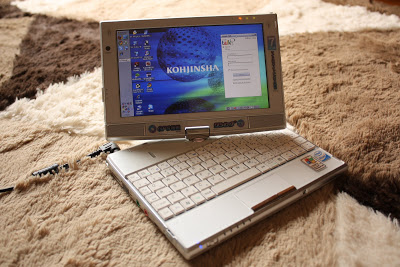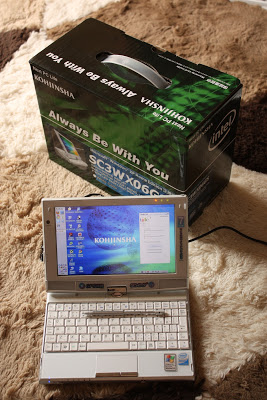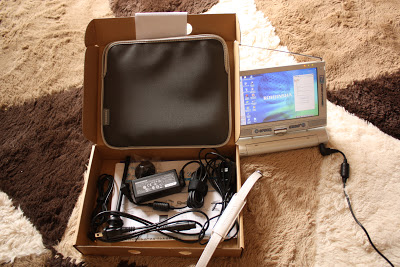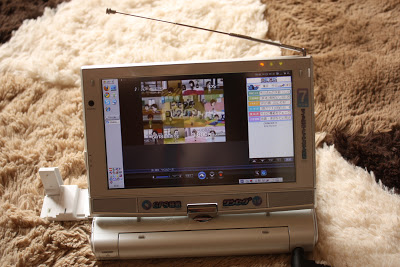Netbook Review / UMPC Kohjinsha SC3

I want to tell you about an interesting instance of a netbook that fell into my hands. 7-inch swivel screen, touchscreen, GPS, and less than a kilogram of weight - almost my idea of a netbook. The model is available for the Japanese market. Under the cut more photos, those. characteristics and impressions of use
Should I call it a “netbook”, although the manufacturer calls it a UMPC? I call a modest weight, a modest performance, a modest diagonal and a price of ~ $ 400 - isn't this a netbook?
It so happened that, with a visible variety of netbooks in stores, we have to choose from three main segments: the shiny Sony Vaio P series (to be honest - good, but expensive), the gray mass from ASUS EEE, Acer Aspire One, DELL Mini, HP, and more exotic and less popular gadgets like Kohjinsha. By the way, this model is not the only one in the family, but the others are painfully ugly.

Here is what the booklet tells us:
')
Kohjinsha SC3WX06GS
Intel Atom Z520 (1.33GHz)
Intel chipset / video US15W
1Gb DDR2-533 (Expands to 2)
7 '' 1024x600 swivel, touchscreen
84-key keyboard, Ctrl first left
60Gb HDD
100BASE-TX / 10BASE-T
LAN IEEE802.11 b / g
Bluetooth 2.0 + EDR
Realtek High Definition Audio
1.3 mpix. camera
GPS
1seg. Tv
ExpressCard / 34, SD card slot 3in1
820g

What struck me device - swivel touch-screen. One word - Tablet PC. Clarity, brightness - at the level. After an old Macbook, it seems to me too bright. Comes with a telescopic stylus, for it has a special groove. The quality of the touch-screen - probably like any touch-screen, designed for the stylus. Of course, not an iPhone, but the technologies are different. By the way, reading Google Reader with the expanded screen and poking a finger at subscriptions and articles is very cool, convenient and natural.

Equipment:
TA-dah! they did it, and put 2 (two) power supplies in the box (which the advertising booklet happily reports), only two batteries are cooler, which is lower. It is really convenient, for example, to throw one block at home, the other at work. Or one in the room, the other in the bedroom. Power supplies are standard, 100 - 240 volts.
Still in the set: rag envelope of suspicious color but decent quality; like a leather handle, attached directly to a netbook - not used by me; external antenna for GPS; external antenna for TV; paper-disochki.

Interfaces on the sides: sound / microphone, rudder volume, VGA, two USB2.0 (one closes with an elastic band), connectors for antennas, behind a connector for a power supply and LAN (also closed with an elastic band). On the left of the screen is a two-position key, you can put a change in brightness / Page Up-Down / Zoom on it. When the screen is expanded - the key is conveniently located at hand. To the left of the screen - the camera. Skype sees it - more from it is not necessary. A bit unusual, the camera shoots a little on the side.

In Japan, now almost all netbooks in the price range of $ 300- $ 500 are distributed free of charge, provided they are connected with a two-year contract to the EMOBILE network. Although the girl tried to shove the USB-shny adapter, I resisted and chose ExpressCard / 34, as a result I received both the adapter and the netbook for free. Friendship with the adapter went surprisingly without problems, when the adapter was plugged in, firewood was supplied from the built-in flash drive and each time the utility was launched with one Connect button. When you close the utility, the connection is broken, in general, what you need.

Communications:
1 seg. TV - works, but, to be honest, the screen for TV is bigger. The resolution of the transmitted picture is small, for phones the most that, but for a netbook - only in the window. I am interested in this kind of art weakly, I somehow don’t really get sick with baseball, and the rest is Japanese TV from what can be caught by mobile receivers - I have nothing to watch.
GPS:
The apartment earned only with an external antenna, in the fields to check it was not possible yet. Comes with software for the Japanese market with large buttons, suitable for finger poking. Step by step navigation, search stores, all the cases.
Wi-Fi:
The impression was made that the power of the receiver was insufficient, in some places of the apartment it falls off where the rest of the iron works.
An interesting detail: GPS and Bluetooth are not available on some models. With GPS, everything is clear, but why cut off Bluetooth?

Keyboard:
Japanese, with a twisted left side, there all the brackets and punctuation marks are so severely mixed. Due to the addition of additional keys, the space is rather short, which is standard for Japanese keyboards. The size of the keys - well, what could be the size of a 7-inch netbook. Modest size. As I already wrote, the left control is in its rightful place, all control functions are hot-key + Fn, everything is standard.
On the netbook installed Wyndouz Xpi Num edishn, with a Japanese face, generously decorated with native utilities. One-byte inheritance makes itself felt, so Phar terribly korezh from non-Cyrillic locale, and when you change the locale - half of the Japanese programs flies.

Total:
The weakest point is the battery for 2700 parrots. With careful handling, it lasts for 2.5-3 hours and it’s good time to think about buying an additional, increased capacity, commercially available.
And the rest - I am satisfied, I got what I wanted: a lightweight, non-pulling bag gadget for reading and surfing at home and on the road. With such a subway really comfortable, even standing.
UPD:
On Habré there is still such an announcement here , how much the characteristics, the look and the price tag have changed a lot
Source: https://habr.com/ru/post/62206/
All Articles